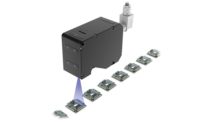NDT - Eddy Current
Advancing NDT Analysis
Automation has improved data acquisition, but it’s time to consider analysis.

EC Probes. Various types of probes used today, from basic to multi-coil array. Source: Zetec

Automated EC Tester & Probe delivery. This is currently used today for delivering two inspection probes into a steam generator vessel automatically testing two tubes at the same time. Inside the vessel is a robot that positions the probes in front of the tubes to be inspected. Source: Zetec

This is an early system used in the 1970s and 80s to acquire data from the inspection probe.

Introduced in the early 1980s, this system digitized the analog signals for display. The analysis process has evolved only in computer hardware and software technology advancements since then but the manual process has remained until about 2010-2011.
While advancements in automation and technology have enabled efficient acquisition of large volumes of nondestructive examination (NDE) data, the advancements in the analysis of collected data have been largely stagnant. The manual process of analyzing and reviewing inspection results has vastly increased in complexity, whereas the time allotted to perform this task has significantly decreased. The end results have exposed many “human factors” as potential weaknesses in the process and solidified the resolute need for a fully automated data analysis process.
To meet this need, an automated non-interactive data analysis program has been developed and used, greatly improving reliability, consistency, accuracy, safety, and also addresses unexpected specimen irregularities. This program addresses specific applications for the eddy current testing (ECT) of steam generator tubing in the nuclear power generation industry. Inspection of nonferrous tubing in nuclear power plants using ECT has been an industry standard practice ever since inception more than 45 years ago. This has proven to be the most efficient and thorough NDT method available for this mission critical and highly regulated examination of steam generators.
Early in the history of steam generator tubing NDE, it was imperative to use cutting edge technology when delivering an examination probe to the test specimen, due to the hazardous work environment. This highly radioactive environment necessitated the use of robotic delivery methods to reduce exposure to radiation, known today by the industry term ALARA (as low as reasonably achievable). Due to the environmental needs, the data acquisition portion of the examination process received constant technological enrichment. Simple by today’s standard, these initial manual robotic manipulators were soon replaced by highly sophisticated fully automated smart robotics. Coupling this robot with machine vision technology and highly reliable and user friendly software, the industry has created a great data acquiring engine—reducing the inspection phase from several months to just a few days.
As inspection speed increased, the inspection probe producing the eddy currents has grown exponentially complex as well. The initial probe was a single frequency analog coil which has developed into a complex array of discrete eddy current coils excited by multiple frequencies that are simultaneously driven through a high frequency imbedded multiplexer circuit, available to deliver hundreds of analysis viewing channels with unlimited inspection potential. However, the historical process of analyzing this vast volume of data has been largely unchanged, or viewed by some industry experts as deteriorated.
This industry has embraced every step of progress towards automating the acquisition portion of this NDE process, but has relatively ignored the even more critical data analysis NDE process. The software enabled systems that display data for a person to perform the manual analysis have evolved, but the human process itself has remained unchanged. There have been semi-auto data analysis systems created and used in the last 20 years that employ simple if-then-else logic, but these have always required consistent human interaction and are for all intents and purposes, no better than the manual system.
In today’s world of technological grandeur, automation is common place and viewed as one of the best ways to safely obtain results and reduce costs associated with labor intensive processes. This is largely due to the fact that automation improves production and quality, while providing reliable and repeatable performance. Whether we like it or not, the fact remains that “human factors” tend to inject risk into processes where human decision making is the key element to a positive outcome. “Human factors” in the NDE industry include, but are not limited to: consistency, repeatability, accuracy, distractions, fatigue, emotion, and pressure or even perceived pressure. Automating the NDE analysis process is not a question of how or when or even convenience, it is a simple, realistic need that will make marked improvement to quality, safety and the environment.
Today practitioners have access to fully automated software enabled inspection that can replace the manual analysis process. Implementation methods are determined by the end user and their specific application, and it allows for partial or full replacement of the manual system. The majority of the human involvement effort is moved to the creation of the “configuration.” This process is performed in advance of an inspection in a controlled, stress free environment, devoid of the typical pressures seen during refueling outages of the nuclear plant.
A small configuration team of engineers methodically reviews the details of the NDE being performed to include test procedures, inspection techniques, reporting criteria, and expected and unexpected specimen anomalies. This process can be related to software programming; the automated analysis configuration is created, evaluated, and tested thoroughly. An integral part of the process is to analyze historical inspection data or data from a similar design steam generator to further test and validate the configuration. The goal being to analyze, classify, rationalize the data, similar to the actual live data analysis. In situations where there is little to no previous data, a signal injection tool can be used to create flaw-like signals and inject said signal into the historical test data. One of the many benefits of using such a tool is to create signals of interest in locations where they may or may not be expected, thus creating an analyzer to find and classify very small signals that can be indicative of a new damage mechanisms. While engineering this NDE configuration well in advance of the inspection is a manual process, the outcome once created is available for the life of the component and is truly automated.
Further benefits of utilizing any automated system is the potential for reducing operational cost associate with high labor rate. Fully automated analysis systems reduce the number of personnel required to travel to job sites during the inspection. Most of the work is prepared in advance, reducing the “on-site” requirements and greatly reducing those travel expenses, especially when inspections incur delays or extensions. Furthermore, with this particular NDE inspection process, the integrity of the tubing is one of the most critical factors regarding safe plant operation. The acquisition and analysis process is critical and highly controlled by procedures and guidelines. The majority of procedures call for two-party analysis to be performed along with an independent tertiary review; typically this equates to a large team of 30 or more. This personnel demand has in recent years been greatly affected by an aging workforce, accelerated pace of data collection, and more sophisticated and complex analysis requirements.
Deploying an automated analysis system is simple. In this two party example, there are several deployment models depending on the level of automation sought. One method is to use two distinctly different configurations that process the data differently, closely matching the manual two-party process. Another option is to use an advanced inspection probe that has two distinctly different test coils and associated NDT techniques. This is essentially like performing two tests of the same part with one pass of the test probe. The configurations are created mutually independent of each other, and each defined specifically to the procedures of the NDT technique resulting in two completely independent inspection techniques and analyses of the same part. The ensuing conclusion of both of these implementation methods has resulted in improved detection and classification of indications of interest, increased inspection quality, control of the human factors that can lead to errors, and consistent reliable results.
Through the development and adoption of NDE data analysis automation, the nuclear power industry has realized improvements normally associated with automation and also have increased the number of inspection techniques that can be rationalized into each NDE driven decision point. Applications may include manufacturing processes that use NDE to measure quality, identify failure mechanisms, to routine inspection of systems or materials using ultrasonic or eddy current techniques. To ensure environmental and plant safety, our future must embrace quality focused practices that embody automation into holistic NDE inspection solutions.

